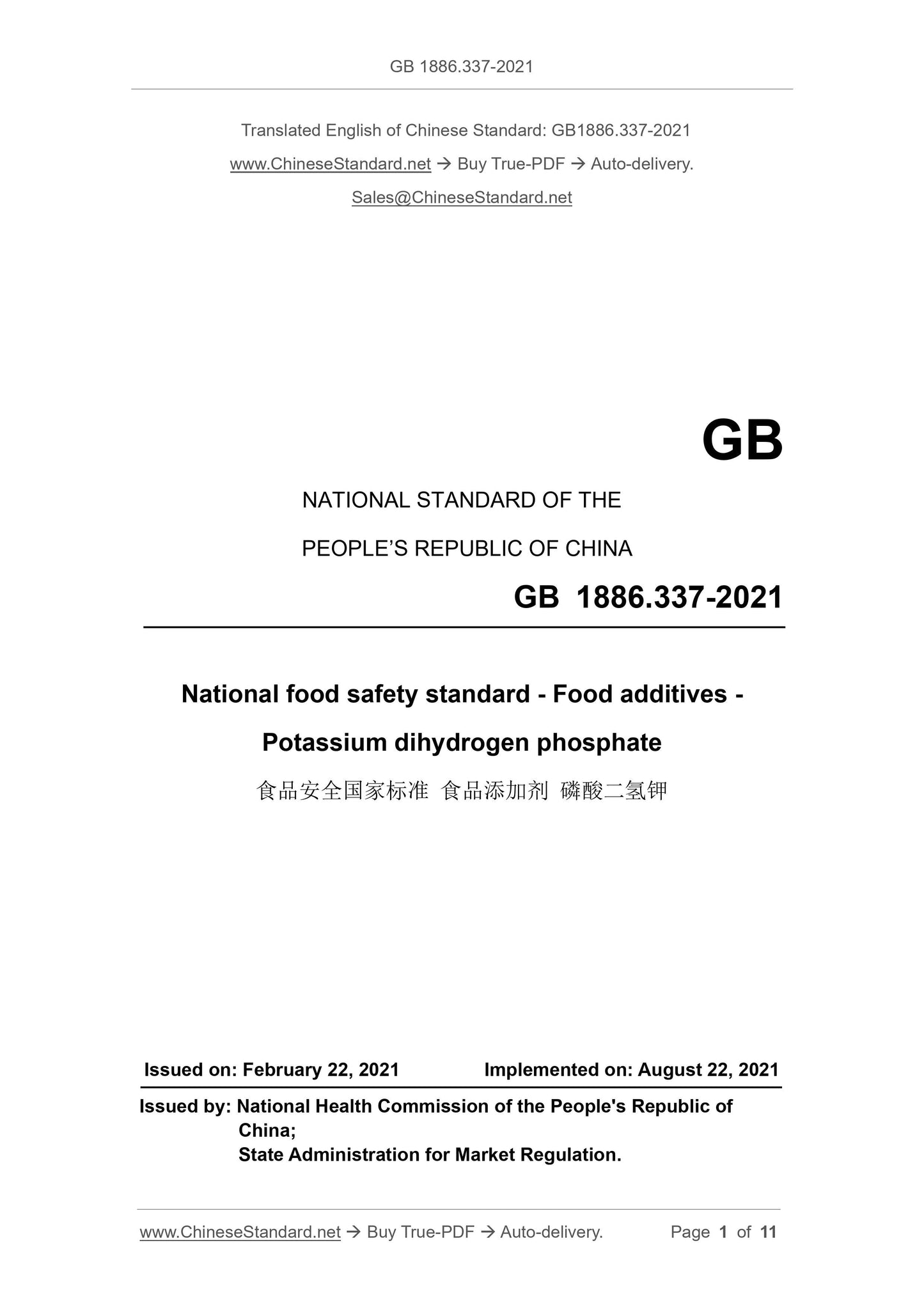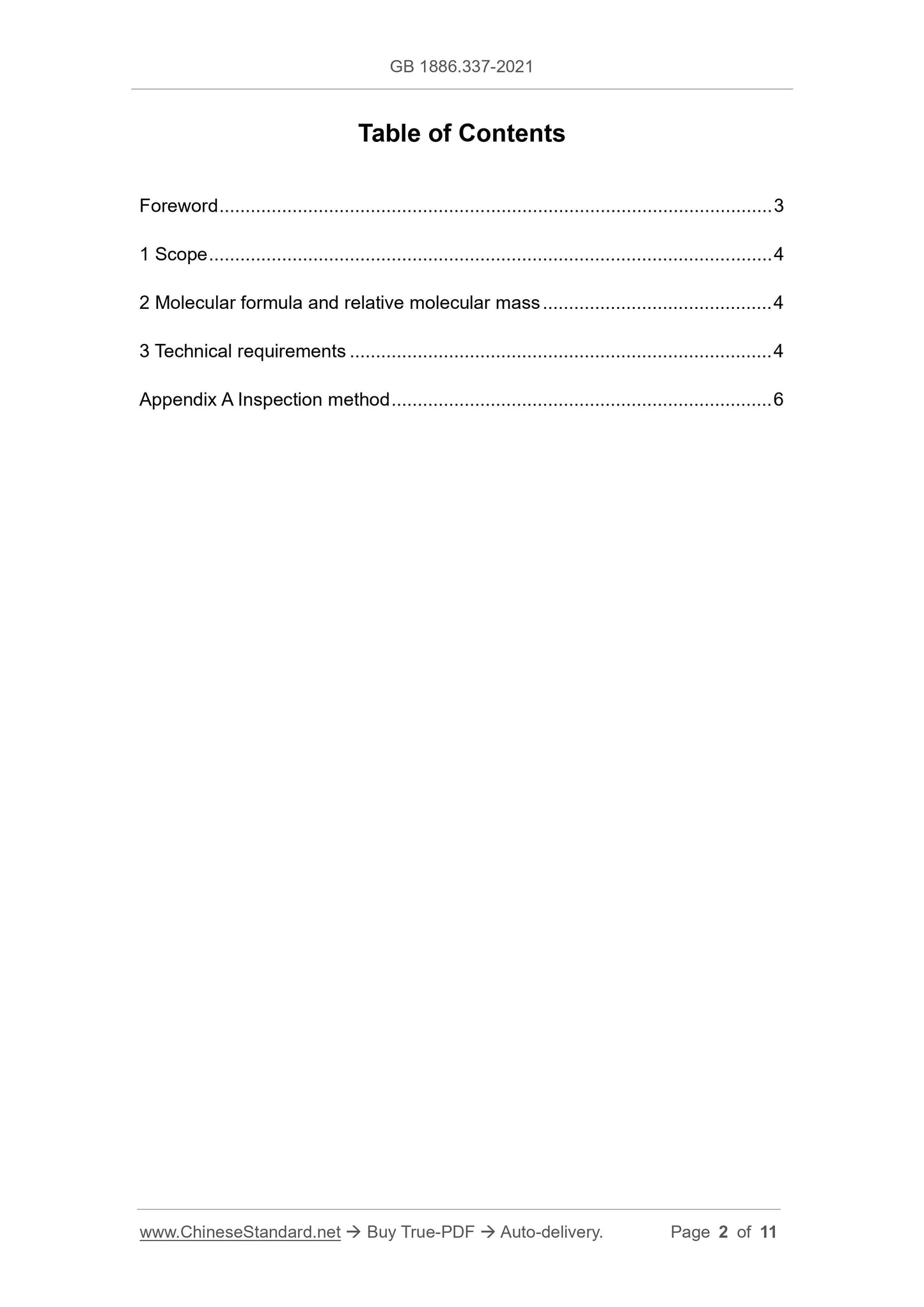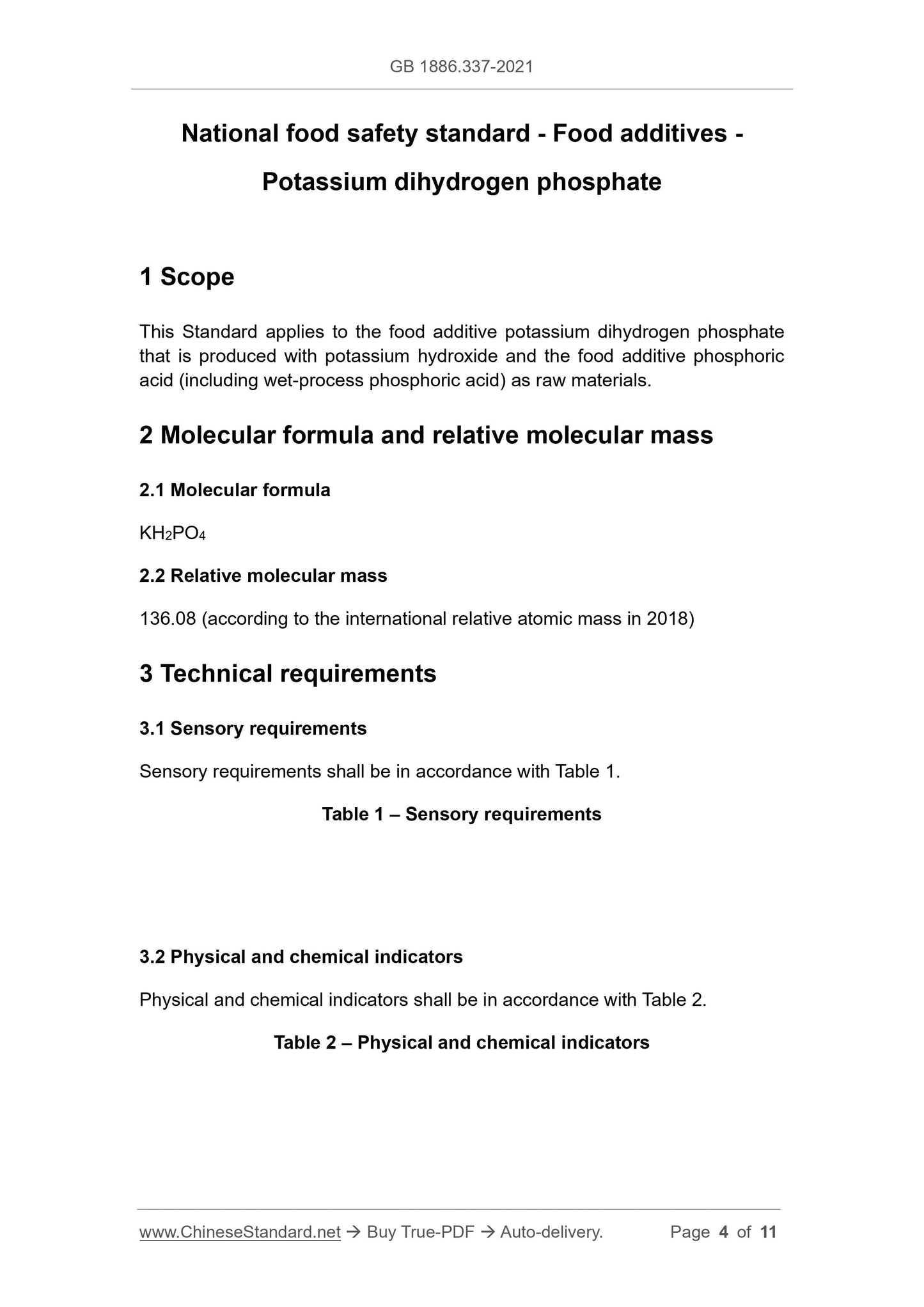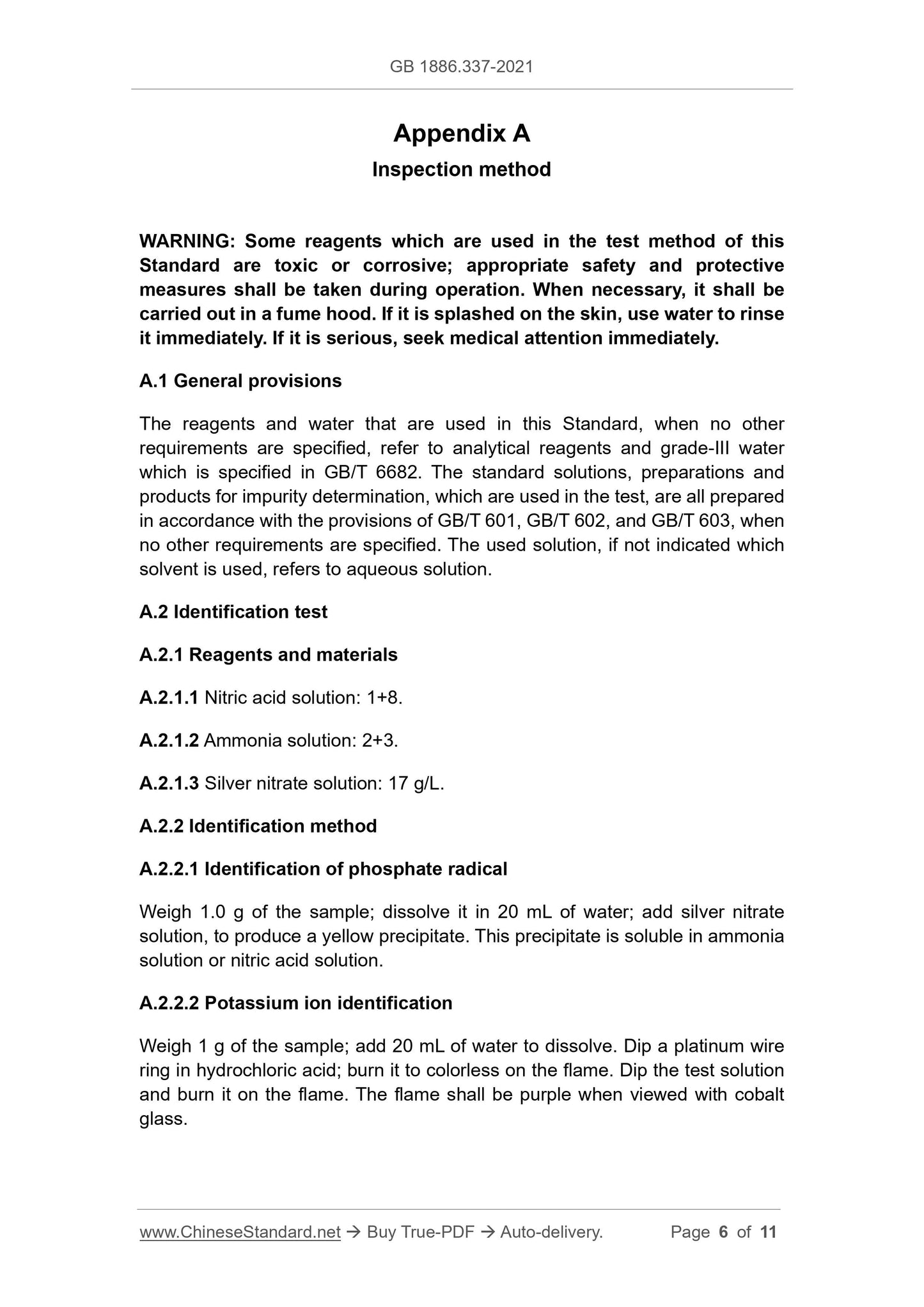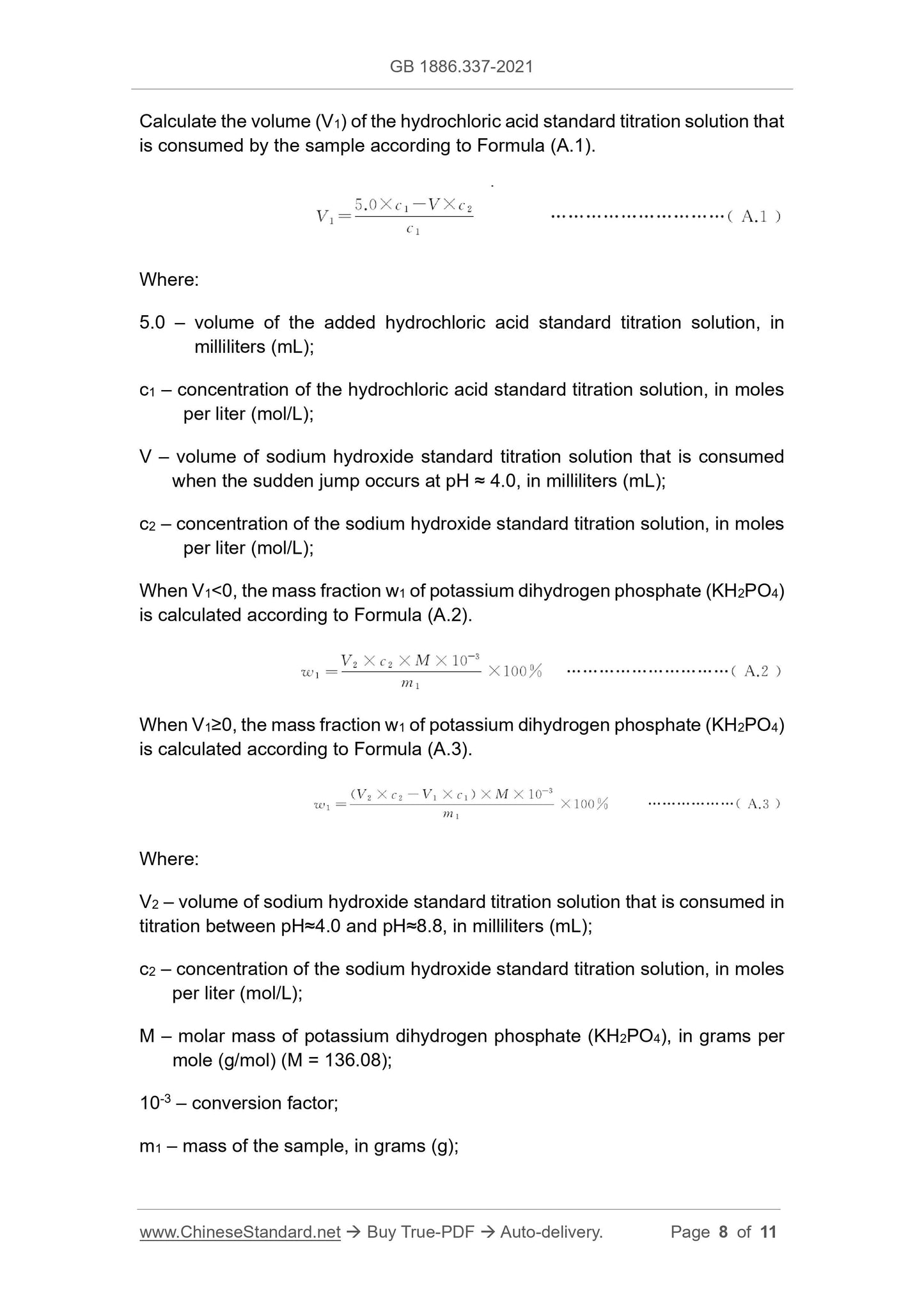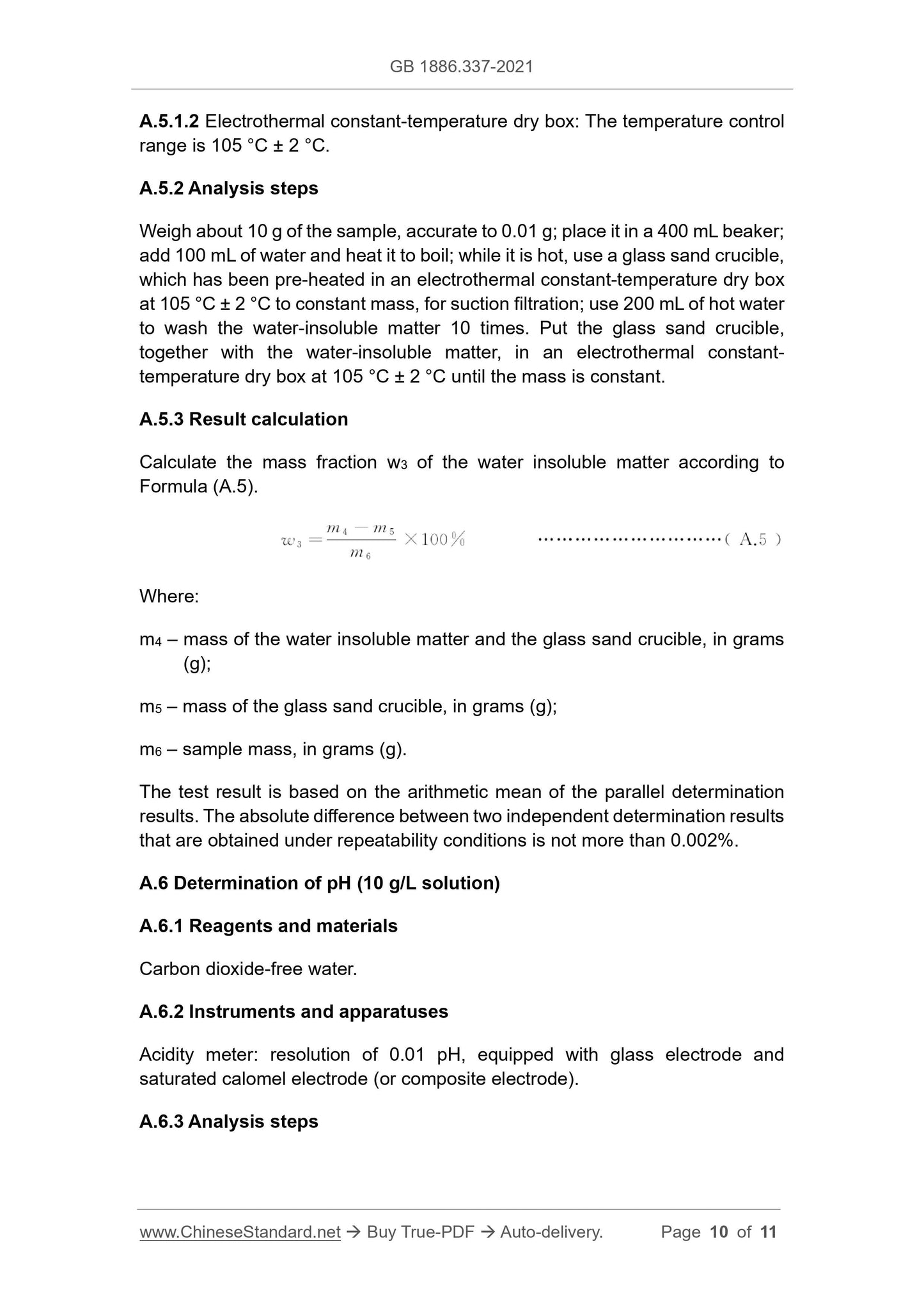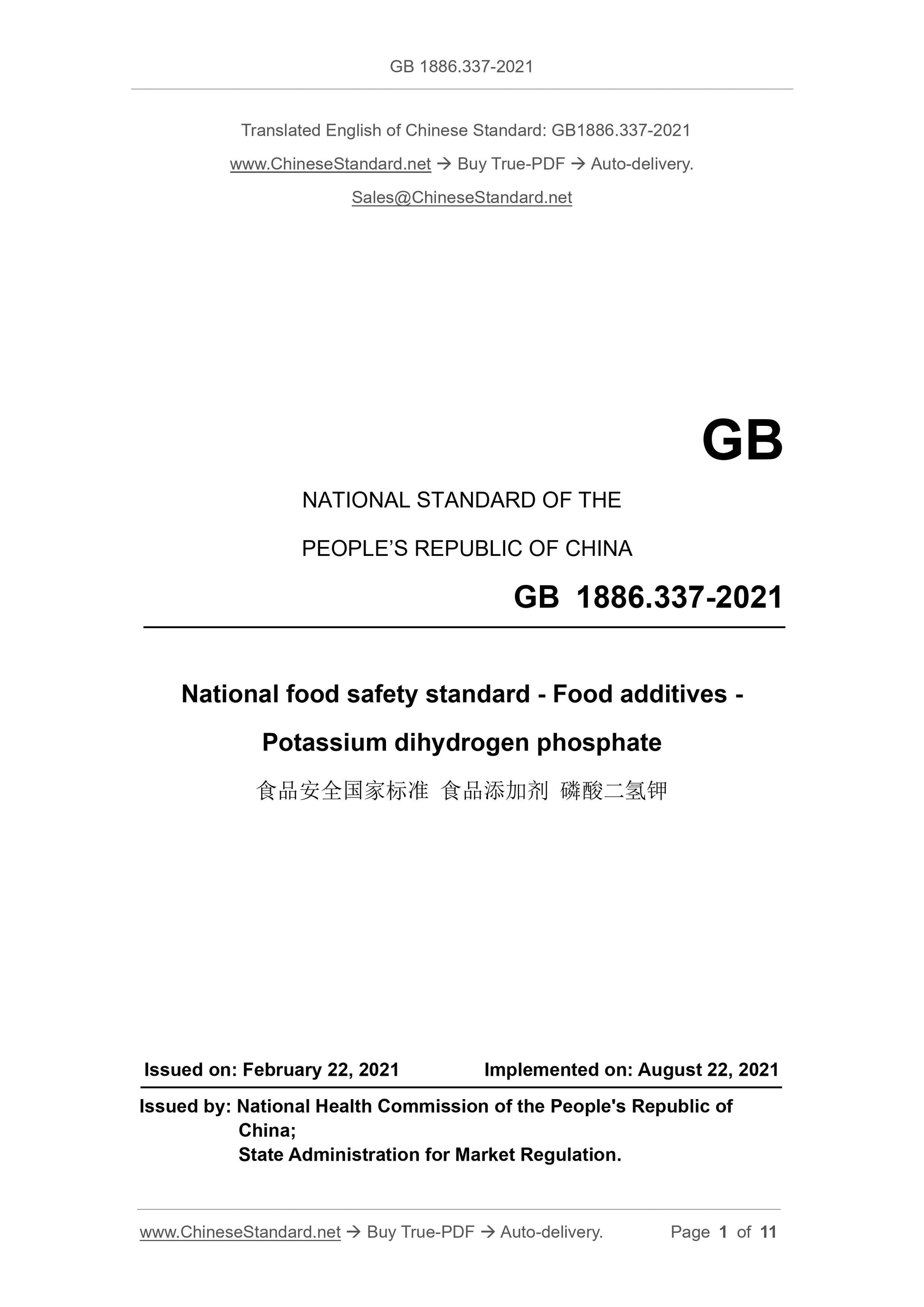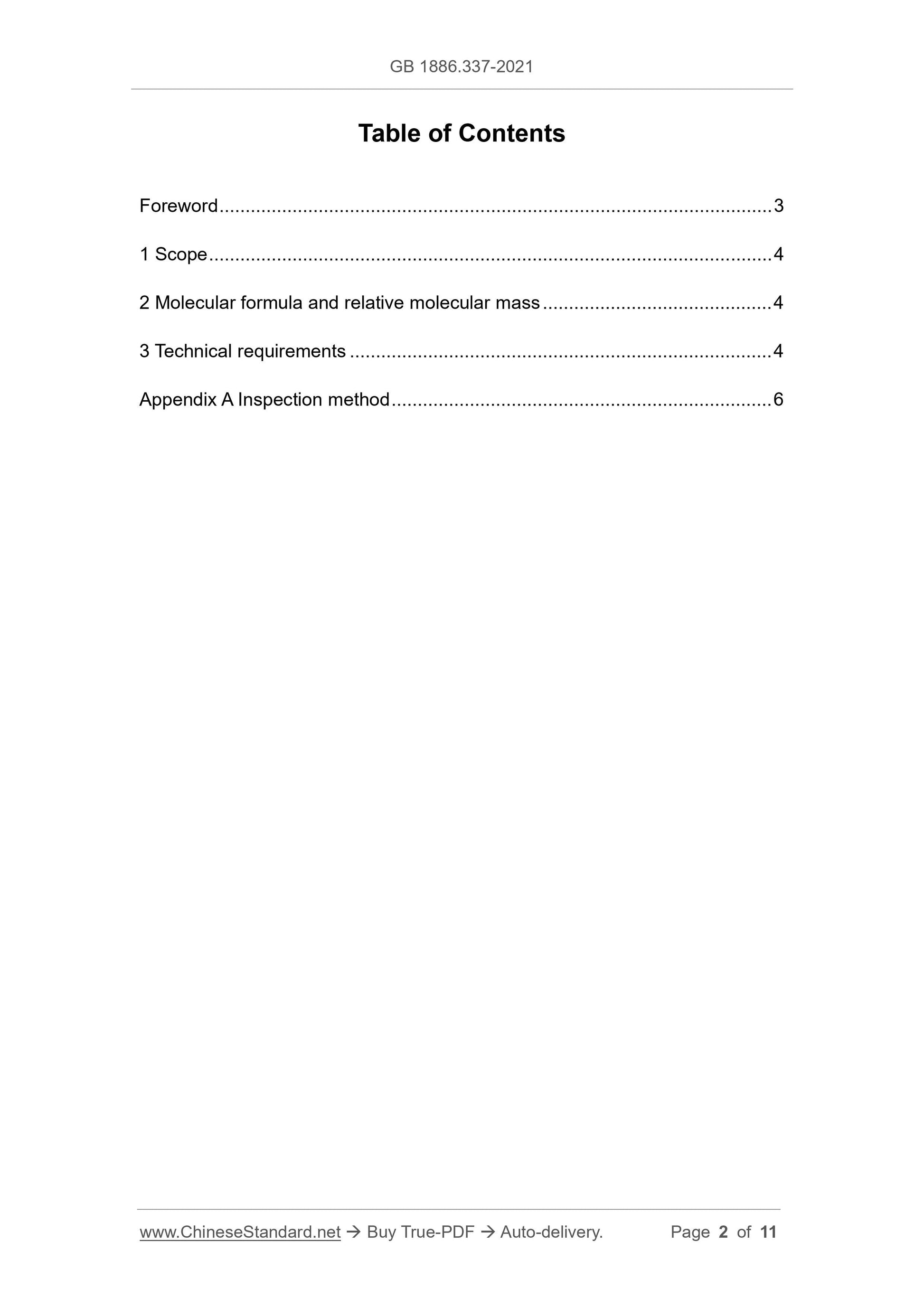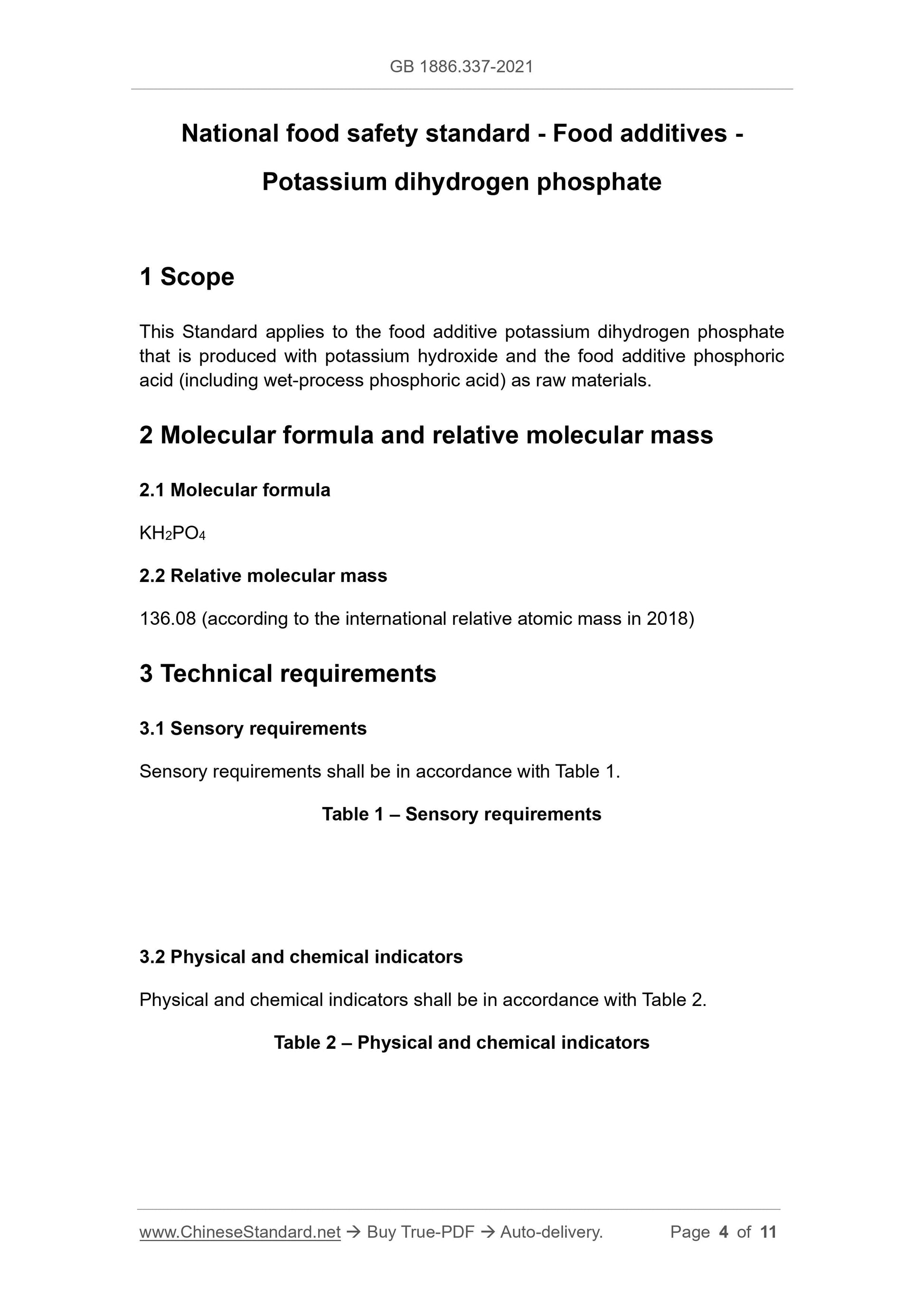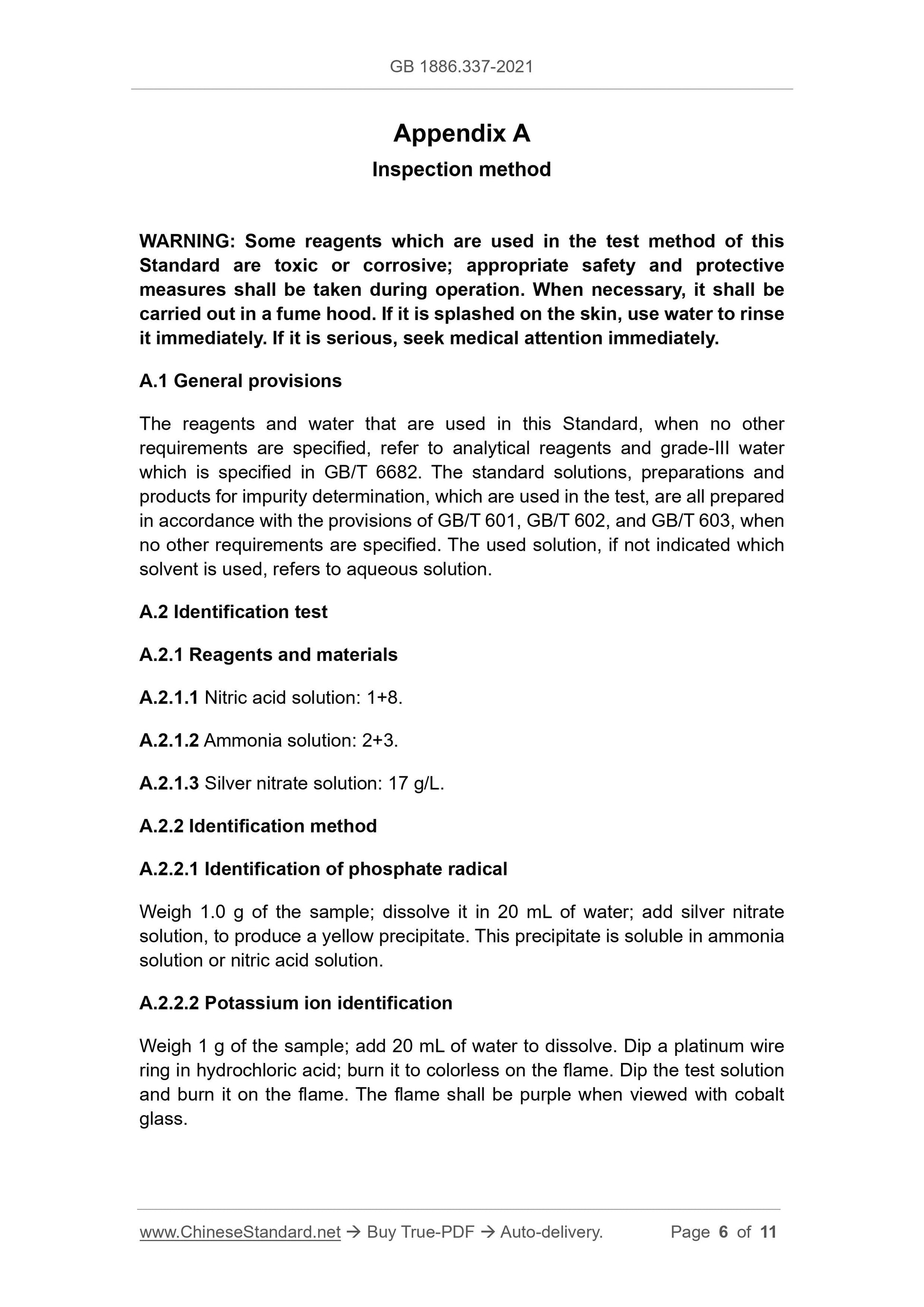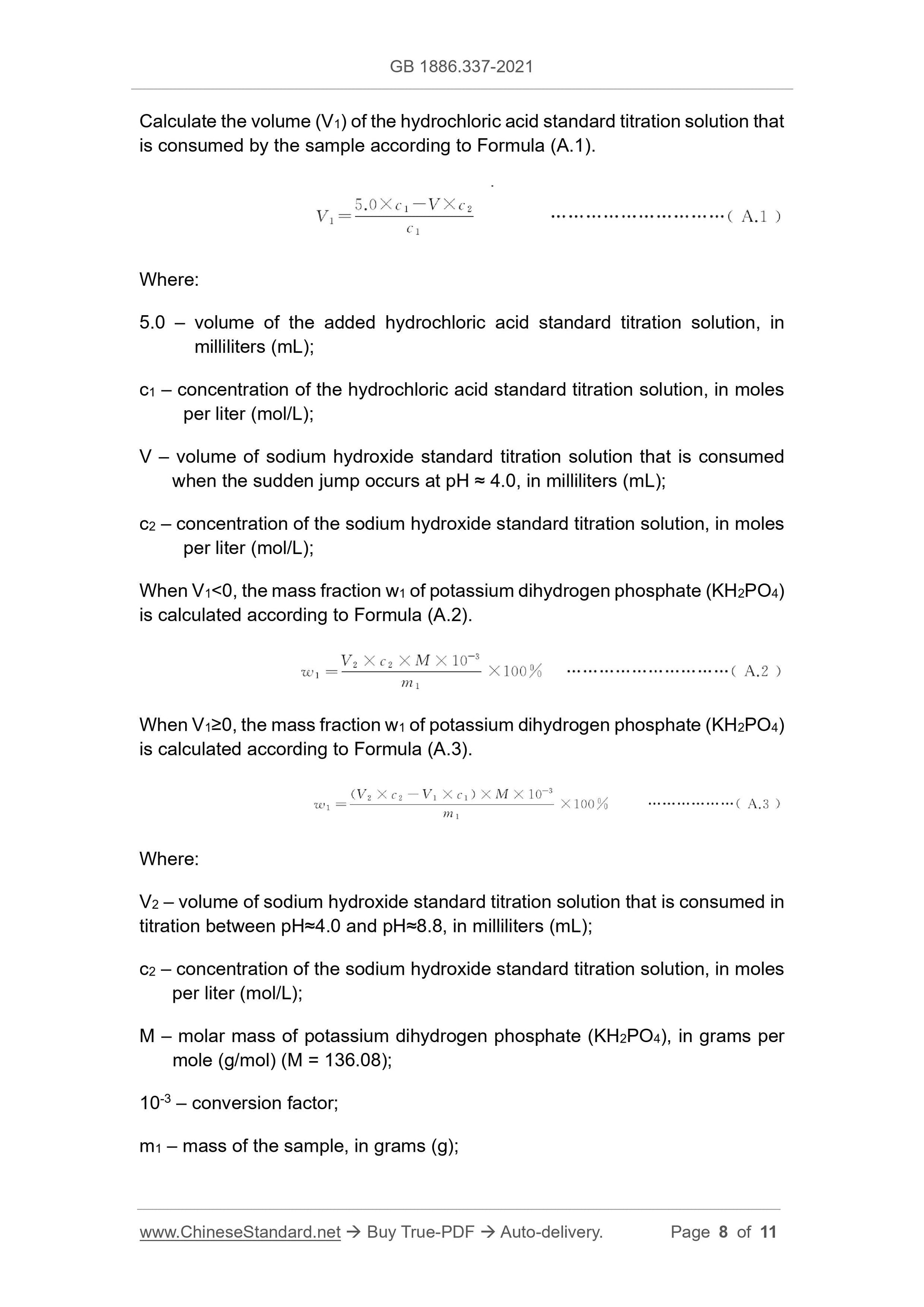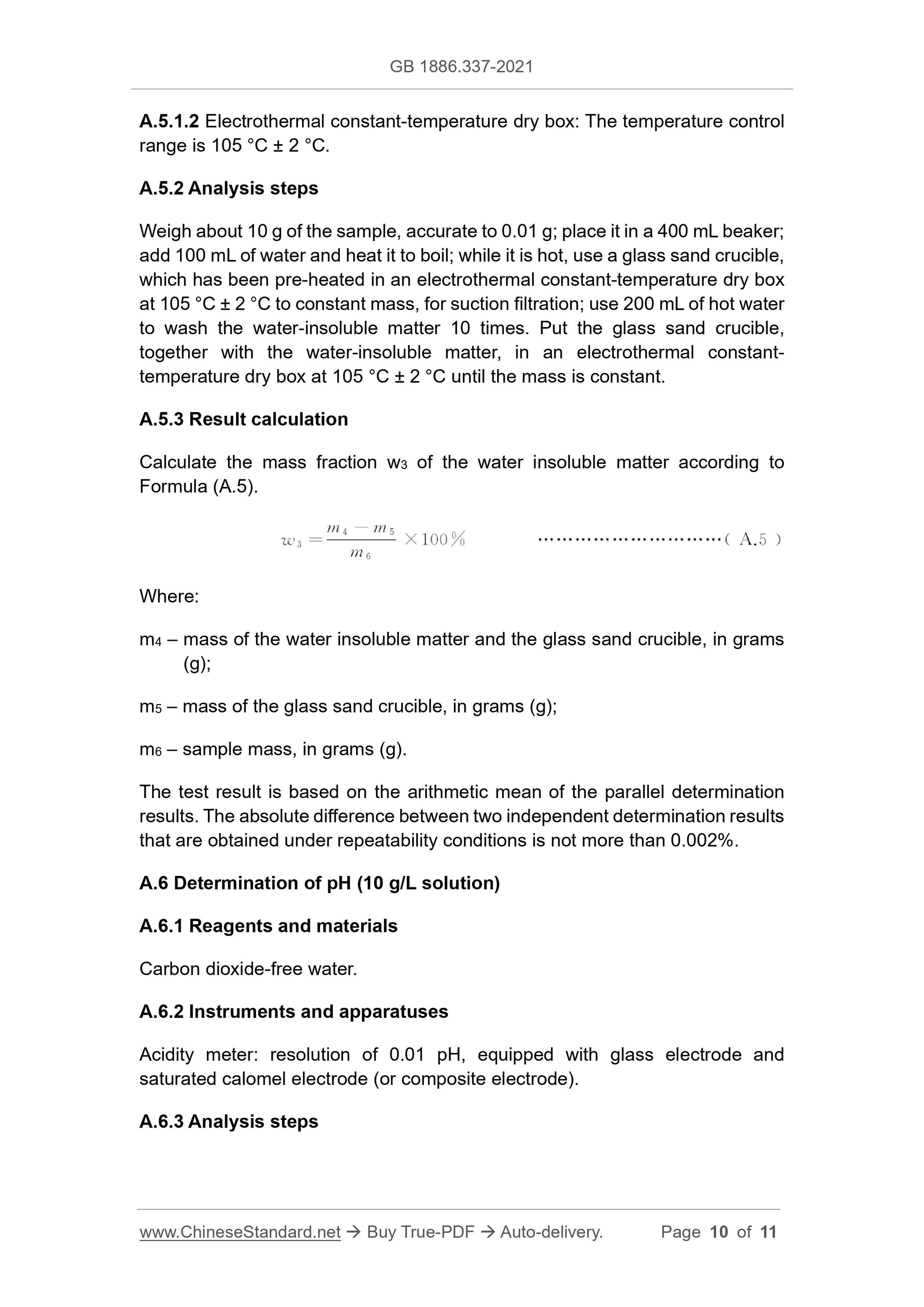1
/
of
6
PayPal, credit cards. Download editable-PDF & invoice In 1 second!
GB 1886.337-2021 English PDF (GB1886.337-2021)
GB 1886.337-2021 English PDF (GB1886.337-2021)
Regular price
$125.00 USD
Regular price
Sale price
$125.00 USD
Unit price
/
per
Shipping calculated at checkout.
Couldn't load pickup availability
Delivery: 3 seconds. Download true-PDF + Invoice.
Get QUOTATION in 1-minute: Click GB 1886.337-2021
Historical versions: GB 1886.337-2021
Preview True-PDF (Reload/Scroll if blank)
GB 1886.337-2021: National food safety standard - Food additives - Potassium dihydrogen phosphate
GB 1886.337-2021
GB
NATIONAL STANDARD OF THE
PEOPLE’S REPUBLIC OF CHINA
National food safety standard - Food additives -
Potassium dihydrogen phosphate
ISSUED ON: FEBRUARY 22, 2021
IMPLEMENTED ON: AUGUST 22, 2021
Issued by: National Health Commission of the People's Republic of
China;
State Administration for Market Regulation.
Table of Contents
Foreword ... 3
1 Scope ... 4
2 Molecular formula and relative molecular mass ... 4
3 Technical requirements ... 4
Appendix A Inspection method ... 6
National food safety standard - Food additives -
Potassium dihydrogen phosphate
1 Scope
This Standard applies to the food additive potassium dihydrogen phosphate
that is produced with potassium hydroxide and the food additive phosphoric
acid (including wet-process phosphoric acid) as raw materials.
2 Molecular formula and relative molecular mass
2.1 Molecular formula
KH2PO4
2.2 Relative molecular mass
136.08 (according to the international relative atomic mass in 2018)
3 Technical requirements
3.1 Sensory requirements
Sensory requirements shall be in accordance with Table 1.
Table 1 – Sensory requirements
3.2 Physical and chemical indicators
Physical and chemical indicators shall be in accordance with Table 2.
Table 2 – Physical and chemical indicators
Appendix A
Inspection method
WARNING: Some reagents which are used in the test method of this
Standard are toxic or corrosive; appropriate safety and protective
measures shall be taken during operation. When necessary, it shall be
carried out in a fume hood. If it is splashed on the skin, use water to rinse
it immediately. If it is serious, seek medical attention immediately.
A.1 General provisions
The reagents and water that are used in this Standard, when no other
requirements are specified, refer to analytical reagents and grade-III water
which is specified in GB/T 6682. The standard solutions, preparations and
products for impurity determination, which are used in the test, are all prepared
in accordance with the provisions of GB/T 601, GB/T 602, and GB/T 603, when
no other requirements are specified. The used solution, if not indicated which
solvent is used, refers to aqueous solution.
A.2 Identification test
A.2.1 Reagents and materials
A.2.1.1 Nitric acid solution: 1+8.
A.2.1.2 Ammonia solution: 2+3.
A.2.1.3 Silver nitrate solution: 17 g/L.
A.2.2 Identification method
A.2.2.1 Identification of phosphate radical
Weigh 1.0 g of the sample; dissolve it in 20 mL of water; add silver nitrate
solution, to produce a yellow precipitate. This precipitate is soluble in ammonia
solution or nitric acid solution.
A.2.2.2 Potassium ion identification
Weigh 1 g of the sample; add 20 mL of water to dissolve. Dip a platinum wire
ring in hydrochloric acid; burn it to colorless on the flame. Dip the test solution
and burn it on the flame. The flame shall be purple when viewed with cobalt
glass.
Calculate the volume (V1) of the hydrochloric acid standard titration solution that
is consumed by the sample according to Formula (A.1).
Where:
5.0 – volume of the added hydrochloric acid standard titration solution, in
milliliters (mL);
c1 – concentration of the hydrochloric acid standard titration solution, in moles
per liter (mol/L);
V – volume of sodium hydroxide standard titration solution that is consumed
when the sudden jump occurs at pH ≈ 4.0, in milliliters (mL);
c2 – concentration of the sodium hydroxide standard titration solution, in moles
per liter (mol/L);
When V1< 0, the mass fraction w1 of potassium dihydrogen phosphate (KH2PO4)
is calculated according to Formula (A.2).
When V1≥0, the mass fraction w1 of potassium dihydrogen phosphate (KH2PO4)
is calculated according to Formula (A.3).
Where:
V2 – volume of sodium hydroxide standard titration solution that is consumed in
titration between pH≈4.0 and pH≈8.8, in milliliters (mL);
c2 – concentration of the sodium hydroxide standard titration solution, in moles
per liter (mol/L);
M – molar mass of potassium dihydrogen phosphate (KH2PO4), in grams per
mole (g/mol) (M = 136.08);
10-3 – conversion factor;
m1 – mass of the sample, in grams (g);
A.5.1.2 Electrothermal constant-temperature dry box: The temperature control
range is 105 °C ± 2 °C.
A.5.2 Analysis steps
Weigh about 10 g of the sample, accurate to 0.01 g; place it in a 400 mL beaker;
add 100 mL of water and heat it to boil; while it is hot, use a glass sand crucible,
which has been pre-heated in an electrothermal constant-temperature dry box
at 105 °C ± 2 °C to constant mass, for suction filtration; use 200 mL of hot water
to wash the water-insoluble matter 10 times. Put the glass sand crucible,
together with the water-insoluble matter, in an electrothermal constant-
temperature dry box at 105 °C ± 2 °C until the mass is constant.
A.5.3 Result calculation
Calculate the mass fraction w3 of the water insoluble matter according to
Formula (A.5).
Where:
m4 – mass of the water insoluble matter and the glass sand crucible, in grams
(g);
m5 – mass of the glass sand crucible, in grams (g);
m6 – sample mass, in grams (g).
The test result is based on the arithmetic mean of the parallel determination
results. The absolute difference between two independent determination results
that are obtained under repeatability conditions is not more than 0.002%.
A.6 Determination of pH (10 g/L solution)
A.6.1 Reagents and materials
Carbon dioxide-free water.
A.6.2 Instruments and apparatuses
Acidity meter: resolution of 0.01 pH, equipped with glass electrode and
saturated calomel electrode (or composite electrode).
A.6.3 Analysis steps
Get QUOTATION in 1-minute: Click GB 1886.337-2021
Historical versions: GB 1886.337-2021
Preview True-PDF (Reload/Scroll if blank)
GB 1886.337-2021: National food safety standard - Food additives - Potassium dihydrogen phosphate
GB 1886.337-2021
GB
NATIONAL STANDARD OF THE
PEOPLE’S REPUBLIC OF CHINA
National food safety standard - Food additives -
Potassium dihydrogen phosphate
ISSUED ON: FEBRUARY 22, 2021
IMPLEMENTED ON: AUGUST 22, 2021
Issued by: National Health Commission of the People's Republic of
China;
State Administration for Market Regulation.
Table of Contents
Foreword ... 3
1 Scope ... 4
2 Molecular formula and relative molecular mass ... 4
3 Technical requirements ... 4
Appendix A Inspection method ... 6
National food safety standard - Food additives -
Potassium dihydrogen phosphate
1 Scope
This Standard applies to the food additive potassium dihydrogen phosphate
that is produced with potassium hydroxide and the food additive phosphoric
acid (including wet-process phosphoric acid) as raw materials.
2 Molecular formula and relative molecular mass
2.1 Molecular formula
KH2PO4
2.2 Relative molecular mass
136.08 (according to the international relative atomic mass in 2018)
3 Technical requirements
3.1 Sensory requirements
Sensory requirements shall be in accordance with Table 1.
Table 1 – Sensory requirements
3.2 Physical and chemical indicators
Physical and chemical indicators shall be in accordance with Table 2.
Table 2 – Physical and chemical indicators
Appendix A
Inspection method
WARNING: Some reagents which are used in the test method of this
Standard are toxic or corrosive; appropriate safety and protective
measures shall be taken during operation. When necessary, it shall be
carried out in a fume hood. If it is splashed on the skin, use water to rinse
it immediately. If it is serious, seek medical attention immediately.
A.1 General provisions
The reagents and water that are used in this Standard, when no other
requirements are specified, refer to analytical reagents and grade-III water
which is specified in GB/T 6682. The standard solutions, preparations and
products for impurity determination, which are used in the test, are all prepared
in accordance with the provisions of GB/T 601, GB/T 602, and GB/T 603, when
no other requirements are specified. The used solution, if not indicated which
solvent is used, refers to aqueous solution.
A.2 Identification test
A.2.1 Reagents and materials
A.2.1.1 Nitric acid solution: 1+8.
A.2.1.2 Ammonia solution: 2+3.
A.2.1.3 Silver nitrate solution: 17 g/L.
A.2.2 Identification method
A.2.2.1 Identification of phosphate radical
Weigh 1.0 g of the sample; dissolve it in 20 mL of water; add silver nitrate
solution, to produce a yellow precipitate. This precipitate is soluble in ammonia
solution or nitric acid solution.
A.2.2.2 Potassium ion identification
Weigh 1 g of the sample; add 20 mL of water to dissolve. Dip a platinum wire
ring in hydrochloric acid; burn it to colorless on the flame. Dip the test solution
and burn it on the flame. The flame shall be purple when viewed with cobalt
glass.
Calculate the volume (V1) of the hydrochloric acid standard titration solution that
is consumed by the sample according to Formula (A.1).
Where:
5.0 – volume of the added hydrochloric acid standard titration solution, in
milliliters (mL);
c1 – concentration of the hydrochloric acid standard titration solution, in moles
per liter (mol/L);
V – volume of sodium hydroxide standard titration solution that is consumed
when the sudden jump occurs at pH ≈ 4.0, in milliliters (mL);
c2 – concentration of the sodium hydroxide standard titration solution, in moles
per liter (mol/L);
When V1< 0, the mass fraction w1 of potassium dihydrogen phosphate (KH2PO4)
is calculated according to Formula (A.2).
When V1≥0, the mass fraction w1 of potassium dihydrogen phosphate (KH2PO4)
is calculated according to Formula (A.3).
Where:
V2 – volume of sodium hydroxide standard titration solution that is consumed in
titration between pH≈4.0 and pH≈8.8, in milliliters (mL);
c2 – concentration of the sodium hydroxide standard titration solution, in moles
per liter (mol/L);
M – molar mass of potassium dihydrogen phosphate (KH2PO4), in grams per
mole (g/mol) (M = 136.08);
10-3 – conversion factor;
m1 – mass of the sample, in grams (g);
A.5.1.2 Electrothermal constant-temperature dry box: The temperature control
range is 105 °C ± 2 °C.
A.5.2 Analysis steps
Weigh about 10 g of the sample, accurate to 0.01 g; place it in a 400 mL beaker;
add 100 mL of water and heat it to boil; while it is hot, use a glass sand crucible,
which has been pre-heated in an electrothermal constant-temperature dry box
at 105 °C ± 2 °C to constant mass, for suction filtration; use 200 mL of hot water
to wash the water-insoluble matter 10 times. Put the glass sand crucible,
together with the water-insoluble matter, in an electrothermal constant-
temperature dry box at 105 °C ± 2 °C until the mass is constant.
A.5.3 Result calculation
Calculate the mass fraction w3 of the water insoluble matter according to
Formula (A.5).
Where:
m4 – mass of the water insoluble matter and the glass sand crucible, in grams
(g);
m5 – mass of the glass sand crucible, in grams (g);
m6 – sample mass, in grams (g).
The test result is based on the arithmetic mean of the parallel determination
results. The absolute difference between two independent determination results
that are obtained under repeatability conditions is not more than 0.002%.
A.6 Determination of pH (10 g/L solution)
A.6.1 Reagents and materials
Carbon dioxide-free water.
A.6.2 Instruments and apparatuses
Acidity meter: resolution of 0.01 pH, equipped with glass electrode and
saturated calomel electrode (or composite electrode).
A.6.3 Analysis steps
Share
